I am from a family with Indigenous Latin American and German ancestry. I have been to many different countries and lived in different places. I believe this is partly because the Indigenous tradition my family comes from is nomadic. They see the earth as a living entity, and if they stay in one place they believe the land gets sick. They travel to where their ancestors send them, and this and other important messages are conveyed through their dreams. I married into a Cree and Blackfoot family where ceremonies are performed with the Blackfoot in Alberta. My son also married into a Maori whanau (family) in Aotearoa, New Zealand.
This inter-weaving of bloodlines gives me a perspective of many different Indigenous communities. I am no expert in any of them, and I do not speak for any of them. I also find it difficult to pinpoint only one place where I “come from.” In part, this is because I believe that the earth is alive and upset about fences and divisions. It is also because the tradition of being always on the road, crossing many different types of borders means one has to feel the pathway itself as a place too: one that enables you to see different patterns, different connections, as well as many similarities, and that offers a different kind of contribution to the whole. From this place, I would like to offer a story that speaks to the crossroads and the in-betweens.
I was coming out of a meeting at the University of British Columbia (UBC), where I work, and I found on the floor a dead hummingbird; it looked like it had died recently. At first I did not know what to do as I did not want people to step on the tiny bird. I could not leave it there, so I decided to wrap the dead body of the hummingbird in my scarf. I sang it a couple of songs, and put it in my bag because I was going to a lunch meeting and could not go straight home. I went to the meeting, had lunch, and really forgot about the hummingbird.
If we cannot see the hummingbird, it is because we are sleeping. People who were oblivious to the hummingbird, seemed to be so much in their heads, in their minds, that they could not really notice him: they were in torpor. I spend part of my life in torpor too.
The hummingbird was slowly awakening and started flexing his wings, but his feet seemed to be entangled in my scarf. I took him outside in the scarf, but he would not fly. I thought: I’d better take him back to the tree where I found him, and then maybe he will know what to do. I started walking on campus; to get to the tree, I had to go counter-current through a lane full of people. It was a busy time when students had just finished their afternoon classes. I was carrying a scarf with a hummingbird flexing his wings, as if he was hovering on top of it. I had a miracle in my hands, going through that crowd. What really broke my heart is that nobody looked at the hummingbird. Nobody saw it. As I approached the tree the hummingbird flew away. And that was the end of my encounter with the hummingbird.
I went back to my office, and I started to research where those UBC hummingbirds come from. They come from Mexico. I also found information about the state that the hummingbird was in when I found it. When hummingbirds find an external threat, they go into a state of sleep where just eight percent of the bird’s metabolism keeps it going. This state is called torpor. In this state, they look dead. They take about an hour to “wake up” when the threat has been overcome. Maybe being in my bag protected by the scarf just gave him the warmth to come back to life again.
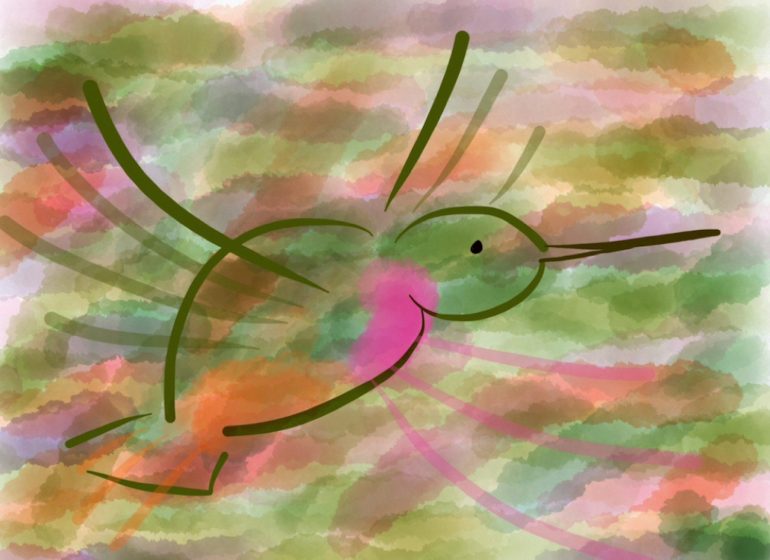
As I told the story to my Cree partner, he asked me to pay attention to what the hummingbird came to teach me. Reflecting on the hummingbird’s teachings took me back to the people walking without the ability to notice the hummingbird flexing his wings on top of my scarf. I believe the hummingbird was trying to teach me about torpor — the state of torpor of the people, who could not see him, as well as my own torpor. If we cannot see the hummingbird, it is because we are sleeping. People who were oblivious to the hummingbird, seemed to be so much in their heads, in their minds, that they could not really notice him: they were in torpor. I spend part of my life in torpor too.
From that point on, I started to think about an education that can awaken us all from torpor. I also started to think about this state of torpor in relation to what we are protecting ourselves against: what has created the state of torpor. If there is a threat that is prompting us to fall asleep, if we do not understand or face this threat, it is going to be extremely difficult to wake up from that state. And if we do not see the implications of being asleep, we might not want to be awakened, because we may be afraid of being awake. I imagined all these people coming to me with huge sleepy heads and very little bodies—heads that scale up our sense of importance, our sense of entitlement, our sense of control of everything, our sense that we are in a bubble that separates us from each other and protects us from the world. It is this sense of separation that presents the world as a threat, as something we need to be protected against and this creates a form of existential poverty.
Existential poverty is a denial of relationship (Donald, 2012), a denial of entanglement, a denial that our lives (both human and non-human) are all inter-woven. This denial leads to torpor and to the fear of awakening. Existential poverty also leads to material poverty because by trying to protect ourselves from each other, we start to accumulate stuff as walls between ourselves. We think that “stuff” is going to give us the affirmation of individuality and security that we believe we are entitled to.
I started to think about what has been scaled down so that the head could be scaled up. What has been scaled down for me is our sense of visceral connection with each other. We have been told that thinking is everything; that “we are” because “we think”; that reality is only what fits our enlarged bubble thinking heads. We have been taught to think about ourselves as much smaller and more limited than we actually are. I started to wonder about an education that could scale up what has been scaled down, that could un-numb the sense of visceral connection, and the responsibility that this entails. But also, the idea that we can scale up and connect the unique healing medicines located in our (different) bodies so this combination of medicines can contain and heal our collective pain, all the pain we have inflicted on each other.
We tend to think about hearts as limited, and to be afraid of the pain that we are going to face in the world because we may feel that our hearts are not strong enough to take it in. But as I was thinking about the teachings of the elders that have been in my path—and I have had the privilege of having elders in different traditions—I realized a common pattern. They have taught me through different stories and by example that we can scale up and connect our hearts. The same way that we can scale our hearing, so we can focus our hearing on something that is near or something that is far in our sight, we can make our hearts smaller, or bigger, enormous. Our sense of identity can also be perceived in the same way. We can be just this body, this ego, a defined identity, or we can be unbound spirit, we can be part of everything. Our sense of land could be just our home, our reserve, our country, or it can be the whole earth, or the whole universe.
Part of the problem with the kind of education we receive at university and schools is that we forget how to scale up the important things. And we scale down things like generosity, compassion, humility, in order to be able to participate in a system that has given us a few gifts, but that depends on violence to be maintained. So here I draw on Cash Ahenakew’s (2014) work to talk about this paradox that we face as Indigenous people all over the world. This paradox has two sides. On the one hand, there is the necessity to survive in a modern capitalist context that is inherently violent and completely unsustainable, a system that makes life outside of it almost impossible, unless we are “off the grid.” We have to fight for our lands, our rights, our languages and our cultures using the language of the nation state, if we want to be successful.
On the other hand, and at the same time, if we know that system is unsustainable, we have a responsibility to give our children an alternative mode of existence that might not be defined by that system. So how do we do the two things together, knowing that the first system tends to define our existence very quickly? Do we as Indigenous and non-Indigenous educators, as people who are here to support young people, just support them to get through the system and then they become one of the people who came towards me and could not see the hummingbird? Or do we just socialize them in traditions where the hummingbird is one of the most important things to be seen? Can we train them to be successful in the existing system and to be awake, to be able to see the hummingbird? If they are awake and within the colonial system, will they be able to survive the pain without knowing how to connect and expand their medicines and hearts?
I believe these are discussions that we need to have. We have been thinking about an education for walking both worlds, but we have not yet really talked enough about the difficulties and the complexities of doing that, in the sense that young people feel torn, or sometimes fall through the cracks of both worlds (Battiste, 2000). Perhaps one way to think about it is through the concepts of material and existential poverty, and material and existential wealth. We need to think about the ways that material wealth, which has been associated with affluence, competition, and individualism, has caused a lot of existential poverty. So, how do we pass a notion of existential and material wealth to our children that upholds the dignity and wellbeing of every being, both human, more than human, and non-human, a notion of wealth that does not harm other people or the planet and that honors ancestors as people who have come before and of people who are yet to come?
This is the kind of education that I have been thinking about in terms of working at a university that, after this experience with the hummingbird, feels very much like an ivory slum, in terms of the existential poverty it promotes. Within this context, I also wonder about what reconciliation means and what it looks like. When I get really frustrated, part of me starts thinking about exiting: I just want to get out of institutions, return to community, forget about the university. Another part of me remembers that the process of reconciliation requires us to be where the problems are. I am not talking just about the reconciliation related to the effects of colonial violence, but about the (difficult) sense of wholeness and oneness that we have to have if we want to open the possibility for another form of existence in this planet. It is a reconciliation that starts in our guts and stretches out to recognize our inseparability. In many ways, being in the ivory slum is extremely important. And it is also really hard. And it is very difficult to face that existential poverty and not know what to do.
I find courage when I manage to de-center and to trust that there is an ancestral vision guiding where I go, a vision that knows why I was sent to this place, even if I do not know. That is what I try to say to myself in moments of extreme frustration. This helps me remember that the process of turning towards existential wealth involves dealing with the existential poverty that we see around us and within us. And that the “us and them” mentality works for certain things to a certain extent, but ultimately does not really speak to that yearning that we have inside of us, which is a yearning for wholeness, for wellbeing, for connection. This can only be achieved when we are together.
As an Indigenous scholar from Trinidad, Jacqui Alexander (2005) has pointed out that we confuse this yearning for wholeness with a yearning to belong, or a yearning for identity, for individuation, or for affirmation. And that, again, works in certain contexts and has saved many lives. I am not dismissing that. But maybe that yearning will only be addressed in the long term, not necessarily through more thinking or more dialogue, but through a renewal of our relationships, and our awakening to this visceral sense that we are individually insufficient and collectively indispensable. Regardless of what has happened in the past, if we use the same frames of being that create violence to resist violence, we will reproduce more violence. If focusing on thinking alone, on “making sense,” is not the answer, what else can we scale up so that we can remember to listen and relate to every being, not necessarily through conceptual language, but through our bodies and our spirits? How can we remember how to “sense sense,” to access other forms of reasoning, without dismissing the gifts of the rationality that we are over-socialized into?
I believe this is what the hummingbird came to teach me that day. I am glad that I did not kill it accidentally by forgetting it in my bag. I am really glad that we both came back alive. The ideas of torpor and of the university as an ivory slum have been very helpful, both in terms of understanding what my role is in that space, and in understanding how my own frustration reflects the same existential poverty that I am trying to address.
Seeing the frustration itself as a trickster teacher, showing me that my ego also reproduces and has been trained in that same kind of thinking, has been very useful. Being able to let go and allow this other vision to come in is very difficult, especially when you have to keep your webpage updated saying how great you are at competing with others: how much research you do, how much knowledge you have, how many articles you have written, how much money and how many awards you have received. I look at it and feel my stomach turn. But I trust there is something beyond myself that moves us where we need to be. It points to the life force within every single one of us, even when we do not want to listen. I believe it sings us a song that speaks of being awake, of breathing, of knowledge coming in dreams, of being undone, of healing and dancing precisely because of the scars we carry. It invites us to a natural state of vulnerability where obsessions with the meaning of an individual lifetime loses centrality as we see the same matter (or flesh), animated by a life-force that precedes it, as constantly morphing into different forms and different learning experiments. In this sense, awakening requires an interruption of our satisfaction with torpor and the false security we have with the illusions of individuality and of control that come with it. Once we let go of that arrogance, we can un-numb our senses and renew our relationships, by noticing that we are, simultaneously, one, many and the creative potential of ‘nothing’, as we inhabit bodies/flesh/form in linear time/reified space—and not—all at the same time.
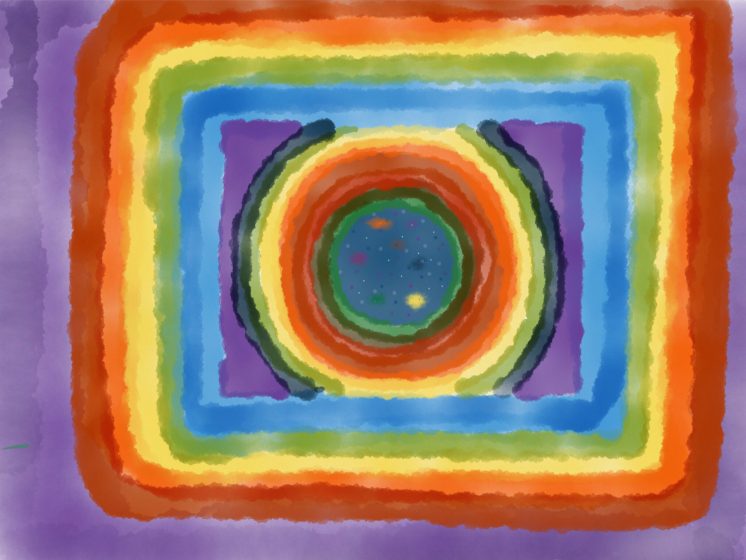
On the other hand, I do recognize that I cannot be in that state all the time, and that there is anger, trauma and childishness within me. And these forms that I take, take me to enclosures of thinking and to a sense of entitlement absolutely grounded in the “us and them” separation, which depends on a denial of my entanglement with everything else. Maybe these entities are also part of entanglement. In this case, the question is how can I encounter these forms of my self productively without being overcome by their narcissistic tendencies? How can I identify and name the colonizers who appear as external to me (obviously I have to do that sometimes) without allowing that definition to determine my relationship with those people, and without seeing myself in them? When should we play the political game, in the pre-defined political context, and when should we breach those definitions and insist on other forms of relationality? Can we do both at the same time? When should we center ourselves for the benefit of our specific communities and when do we de- center to allow the land to imagine through us, for the benefit of all life forms (Longboat & Sheridan, 2006)? If this is not a matter of ‘either/or’ but ‘both/and more’, as my brother Hemi says, how can we mobilize both strategies without having the one least practiced subsumed by the other, which currently colonizes both our hopes and our imagination, giving us safety in a state of torpor?
I must acknowledge the elders who have taught me the most about this. These elders are Keith and Karen Chief Moon and Leroy English who are Blood elders from the Kainai reserve where I sundance. Above all, they show me that humility, generosity and compassion are not intellectual choices, not attitudes you decide to have, but waves that are radiated through you, when you tune to a different wavelength of being. Keith’s story is a beautiful story. For the past six years I have witnessed the process of him sustaining a Sun Dance created from a vision he had forty years ago: of people from the four directions dancing together to reconcile on the land’s terms. According to the vision he received, people would arrive at his Sun Dance, and he would not be able to send them away because it is not the bodies that would arrive—it would be people’s spirits asking to dance. I have witnessed people from other Sun Dances coming and telling him that what he is doing is wrong, because people in the dominant culture are used to appropriating Indigenous knowledge and using it in bad ways. I have heard people saying, “White people will come here, and in five minutes they are going to be bossing Indigenous people around thinking they already understand everything.” And it is true; they are trained to do that.
However, Keith’s response has been really interesting and has taught me something that I did not expect. His response is always that he agrees, on political grounds with the criticisms, but that the land is a sacred place, that his vision is also sacred and that this vision does not require consensus. What he has taught me is that spirituality trumps politics. Seeing him respond with generosity and with compassion to people who act arrogantly or stubbornly due to their torpor or training has helped me to identify and not be afraid to learn from my own arrogance. Keith has established a distinction between necessary political relations that require political agreements and frontiers, and existential relations grounded on visceral connections and wholeness that create a wavelength where frontiers do not exist, a wavelength where all our 99 senses point to the fact that we are each other.
At that Sun Dance I learned there are two groups of elders (who come in many ages): those who insist they know (which is a sign that they don’t), and those who insist they don’t know (who could be on to something). Both are important. Elders in the first group see education as the distribution of answers to be consumed or wrestled with. Elders in the second group see education as a recalibration of a search beyond meaning and the individuated self – a search driven by doubt that often gets stuck in distractions when certainties creep in. The first education gives us languages, concepts and ideas to play and experiment with. The second education demands that we loosen the grip when these things get confused for the path itself, when they become the cement of our ontological securities, getting us entrapped and immobilized precisely by giving us the impression that we are moving somewhere. Combining both types of education requires patience, humor, self-compassion, vulnerability, discernment, and, above all, a healthy skepticism towards one’s own and other knowledges and desires.
Perhaps torpor could be considered as a consequence of the overdoing of the first type of education. When knowledge becomes an instrument of existential arrest we get stuck in distractions. Awakening from torpor does not mean dismissing or banishing knowledge, rationality or identity, but recognizing unhealthy attachments and investments in these things that foreclose on our capacities for a multitude of other possibilities for sensing, reasoning, relating and being. In times of exhaustion or scarcity, hummingbirds shut down their metabolic system. Under conditions of perceived existential scarcity, we may likewise shutdown our capacities, and forget that they exist as we embrace the illusions of safety in our sleep. Perhaps the second education can help us to learn to let go of the strong faith we have on detractions. This may, in turn, loosen the grip that they exert over us, allowing the search to unfold otherwise, awakening our capacities to fly again.
senses
of resonance
of awe
of fusion
of possibility
of form
of being
-in-breathing
-in-beauty
-in-flux
-in-vulnerability
-in-time/space
of embracing
the miracle,
the privilege
the responsibility
of being alive:
both one, many
and nothing,
entangled
unfinished
and free
Vanessa de Oliveira Andreotti
Vancouver
This text is an adapted transcript of a keynote presented at the Indigenous Scholars Conference: Indigenous Epistemologies: Re-Visioning Reconciliation on 26 March 2015, at the University of Alberta. It has been accepted for publication in the Canadian Journal of Native Studies. The article originally appeared in this form on ArtsEverywhere.
References
Ahenakew, C., Andreotti, V., Cooper, G., & Hireme, H. “Beyond Epistemic Provincialism: De-provincializing Indigenous resistance.” Alter-Natives: An International Journal of Indigenous Peoples 10, no. 3 (2014): 216-31.
Alexander, J. Pedagogies of Crossing: Meditations on Feminism, Sexual Politics, Memory and the Sacred. Durham, NC: Duke University Press, 2005.
Battiste, M. Reclaiming Indigenous Voice and Vision. Vancouver, BC: University of British Columbia Press, 2000.
Donald, D. Forts, Colonial Frontier Logics, and Aboriginal-Canadian Relations: Imagining Decolonizing Educational Philosophies in Canadian Contexts. Rotterdam: Sense Publishers, 2012.
Longboat, D., & Sheridan, J. (2006). The Haudenosaunee imagination and the ecology of the sacred. Space and Culture, 9, no. 4 (2006): 365-81.


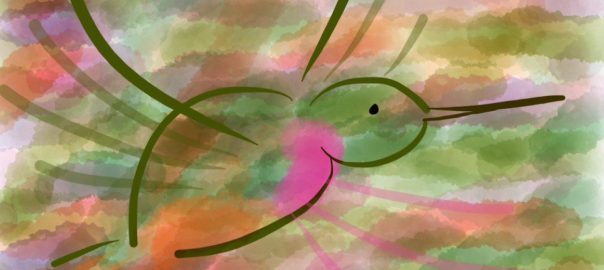
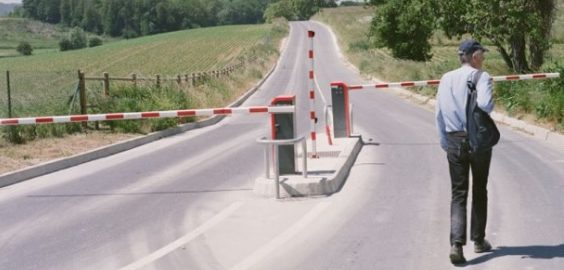
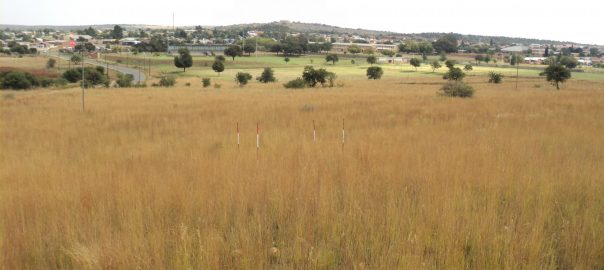
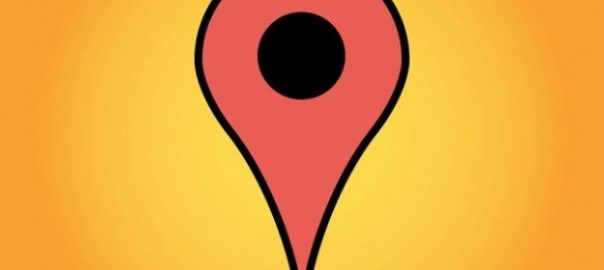
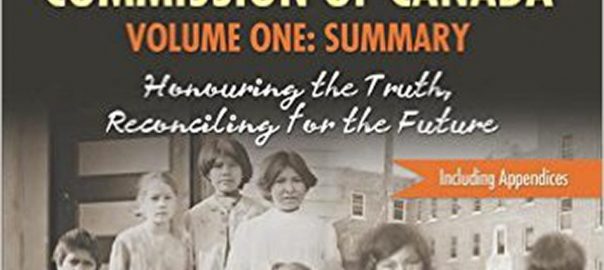
Leave a Reply